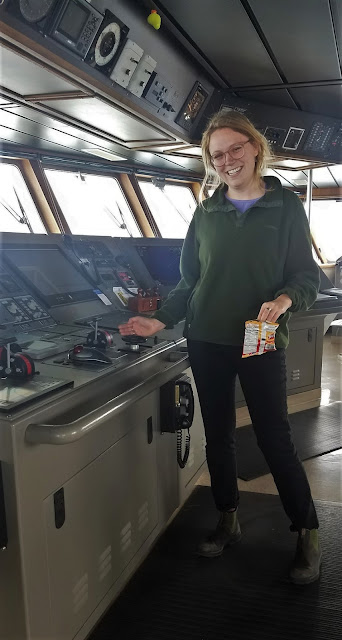(by Emma)
Now that all of
our CTD casts have been completed, our team has started working on other tasks,
and we’ve made time in our schedule for daily Science Meetings. Hilary has
invited other researchers on the ship to discuss some of their scientific
research with us during these meetings. This gives us a chance to learn more
about them and their experiences in depth.
On Wednesday,
we learned about Chief Scientist Alison Macdonald’s research on transport of
water through the Pacific Ocean using chemical signatures. Alison is a physical
oceanographer, which means that she focuses on understanding the physical movement
of water within the ocean. On one of her research projects, she gathered data
on various cruises crossing the Pacific using CTD casts to determine at what
depths a certain chemical signature was found, and how far across the Pacific
the currents carried the signature. Knowing that several specific types of
water, called mode waters, are formed on the western Pacific, Alison could
model the paths and depths of mixing that the water experienced as it moved
eastward, towards North America.
Besides telling
us about the projects she has worked on, Alison also told us about her
experience working on research cruises all over the world. She recently came
back from a cruise on the Southern Ocean, where she was also serving as Chief
Scientist. On many of the cruises Alison has worked on, students are given the
opportunity to operate the CTD for round-the-clock casts. This cruise is a bit
of an exception, as almost all of the casts have been in the afternoon or early
evening hours. Alison also suggested that Lucy and I learn to operate the CTD,
which was very exciting!
Operating the
CTD from the main lab involves keeping track of the sensors and communicating
with the winch as the CTD descends and returns. Dave Wellwood, a WHOI scientist
on board to calibrate the OOI moorings, taught Lucy and I the basics of CTD
operation. Lucy and I learned to how to determine the sea floor depth and how
to politely ask the winch operators to move the CTD to target depths. Watching
the computer monitors for continuous data from the sensors, we manually recorded
the water temperature and salinity at each target depth. At the end of the
cast, we save the data to the server and head out to the deck to sample, or
watch others sampling. I felt quite powerful pressing buttons and firing
bottles for the CTD, although Lucy was the one in charge of winch
communications.
 |
| This is Lucy and Dave Wellwood calling the CTD back up to target depths for an OOI cast. Lucy communicated with the winch via walkie-talkie. |
 |
| This is Dave and I during another CTD cast, watching the graphs showing the sensors’ data as the CTD ascends. Photo by Hilary Palevsky. |
Lucy and I also
took a trip up to the bridge of the Armstrong,
where we had a great view of the ocean. Quinton Edwards (Chief Mate) and Keenan
Foley (Able-bodied Seaman), showed us the navigation system and control board.
The Armstrong has a dynamic positioning system which can keep the ship in a certain position automatically, which is
important for tasks such as mooring deployments. On the bridge, Keenan also
told us about his other trips on the Armstrong,
and his experiences navigating near Greenland, where icebergs are a greater
threat. As one of the seamen on board, he stands watch on the bridge for two
shifts a day and completes other necessary work on the ship.
We are already
steaming back to Reykjavik, and will reach port on Sunday!
Cheers,
Emma


No comments:
Post a Comment